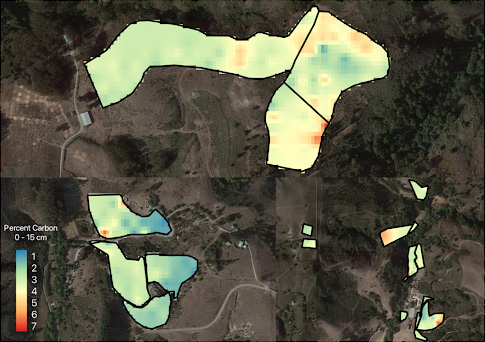Partnerships are central to the work that happens on TomKat Ranch and key to catalyzing transformative action across California’s rangelands and beyond.
Exploring Soil Carbon at TomKat Ranch with The Soil Inventory Project
08/23/2023
By: Chelsea Carry, Point Blue Conservation Science
 Partnerships are central to the work that happens on TomKat Ranch and key to catalyzing transformative action across California’s rangelands and beyond. During the summer of 2022, TomKat Ranch and Point Blue Conservation Science partnered with The Soil Inventory Project (TSIP) to dig deep into key issues around soil sampling and methods standardization, using TomKat’s 1800-acre property as a living, learning laboratory. In total, 243 soil samples were collected over 80 acres and five management units.
Partnerships are central to the work that happens on TomKat Ranch and key to catalyzing transformative action across California’s rangelands and beyond. During the summer of 2022, TomKat Ranch and Point Blue Conservation Science partnered with The Soil Inventory Project (TSIP) to dig deep into key issues around soil sampling and methods standardization, using TomKat’s 1800-acre property as a living, learning laboratory. In total, 243 soil samples were collected over 80 acres and five management units.
While the results of the methods standardization work isn’t yet ready for prime time, another benefit of this project was that it allowed us to intensively assess soil carbon levels across different areas of the ranch. This included one riparian area as well as upland areas that were burned by prescribed fire, grazed by cattle and goats, and amended with compost. We were excited to receive an update report from TSIP recently documenting the findings and wanted to share some of them with you!
- The average percent carbon across these areas was 3.3% from 0-15 cm and 2.6% from 15-30 cm. This equates to 2,654 and 2,041 tonnes of carbon across the 80 acres, respectively.
- As expected, the highest carbon concentrations were measured along Honsinger Creek’s riparian area due to its higher moisture content and productivity.
- Based on the findings, TSIP estimates 106 samples (rather than the 243 we collected) would be needed to confidently estimate the average carbon value across the five management units. This equates to 1 sample for every 0.75 acres.
We are always looking for new ways to bolster our strategy and amplify our impact through partnership, and are grateful for TSIP’s collaboration on this project. We look forward to sharing additional findings related to this work as we have them!

Sample locations across the five management zones sampled during the summer 2022 campaign at TomKat Ranch.

Interpolated percent total soil carbon 0-15 cm at TomKat Ranch.
